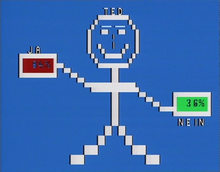Tele-Dialog

Tele-Dialog (abbreviated to TED ) was a televoting process developed by Horst Schättle and Manfred Denninger from ZDF in cooperation with the Deutsche Bundespost (with the telephone as a return channel ), which was used in television programs for non-representative surveys or votes . During a call, a pulse was triggered on a data line that worked simultaneously on a maximum of eight different telephone numbers. So you could choose from a maximum of eight events. At that time, a microprocessor system had been developed at ZDF that made it possible to monitor the eight lines for impulses and to have them processed by the computer. Compared with the previously common audience mail, it enabled a much more direct form of interactive television . A call to vote cost one fee unit (23 pfennigs from the house phone or 20 pfennigs from the telephone booth). The results obtained by telephone could be presented in graphic form without delay during the broadcast.
history
The Tele-Dialog- System was officially presented by Schättle in 1979 at the IFA . In the live broadcast Schauplatz Berlin , viewers put together in a scientific panel cast their TED vote for the first time. One of the first TED surveys was: “Will Hertha BSC become German soccer champions this year?” (At the end of the season, Hertha was relegated from the Bundesliga). Another teledialog question was: “Are you in favor of introducing a television-free day?” At that time, a majority were in favor.
The system came as a block graphic with a yes / no vote in 1981 in the show Wetten, dass ..? and as a simple bar graph for six tunable music tracks from 1982 in the ZDF hit parade in regular operation. The number of callers who could vote was still very limited due to the efficiency of the telephone network at the time. After they had voted by telephone, callers heard the automatic announcement "Your call is counted, please hang up".
Years later, similar systems based on the TED model were introduced in other countries under the name TeleVote . In 1997, the TED was replaced by a more modern, more powerful process called T-Vote-Call (a mass call service using the prefix 0137), which can process a significantly higher number of callers at the same time: up to 100,000 calls per minute. Calls to 0137 are not subject to the normal local or long distance tariff and are usually significantly more expensive. The short name TED has been used colloquially for the new process and was protected by Deutsche Telekom AG as a word mark until February 2019.
There were other TV voting procedures before the TED. During the so-called light test , spectators were asked to switch on electrical appliances. Employees of the electricity works then monitored the increase in electricity consumption.
literature
- Andreas Schmitt-Egenolf: Communication and Computer. Trends and perspectives in telematics, Gabler Verlag GmbH, Wiesbaden 1990, ISBN 978-3-409-18901-9 .
- Jörg B. Kühnapfel: Telecommunications Marketing. Gabler Verlag GmbH, Wiesbaden 1995, ISBN 978-3-409-13197-1 .
- Wolf-Dieter Haaß: Handbook of the communication networks. Introduction to the basics and methods of communication networks. Springer, Berlin Heidelberg 1997, ISBN 3-540-61837-6 .
- Anja Claudia Todtenhaupt: Cyber TV . The digitization of film and television production, Lit Verlag, Münster 2000, ISBN 3-8258-4921-X .
- Jacek Biala: Cellular and Intelligent Networks. 2nd revised edition, Friedrich Vieweg & Sohn Verlagsgesellschaft mbH, Braunschweig 1996, ISBN 978-3-322-87271-5 .
Web links
Individual evidence
- ^ Register information from the German Patent and Trademark Office (DPMA) . DPMA website. Retrieved February 26, 2012.
